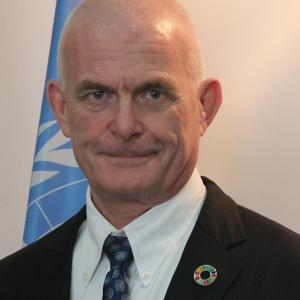Excellency U Henry Van Thio, Vice President of the Government of the Republic of the Union of Myanmar, and Chairperson of the National Disaster Management Committee
Honourable Union Ministers, Members of the National Disaster Management Committee
Representatives of Disaster Management Committees from States and Regions,
Representatives of United Nations Agencies, Development Partners
Members of the Myanmar Earthquake Committee and DRR Working Group
Distinguished Guests, ladies and gentlemen,
MInglabar and Good Morning
———————-
It is a great privilege to join all of you at this auspicious Launching Ceremony of the National Earthquake Preparedness and Response Plan.
As you are all aware, Myanmar is prone to many types of natural hazards, such as cyclones, storm surges, earthquakes, tsunamis, landslides, floods and droughts.
In fact, Myanmar was ranked 3rd in the world in the 2017 Global Climate Risk Index which measures the impact of natural disasters and extreme weather events.
The Myanmar Sustainable Development Plan (MSDP) clearly spells out the strong linkages between natural disasters, human development outcomes and attainment of the Sustainable Development Goals. Natural Disasters everywhere stall and often even reverse hard won development gains by causing loss of lives, destruction of invaluable infrastructure including community assets and livelihoods of people. Recovery from disaster puts significant pressure on a country’s financial and human resources.
I would therefore like to commend and applaud the Government of Myanmar’s efforts to address the threat of natural disasters and climate change associated risks through the strengthening of its national legal and policy instruments, and its active participation in, and contribution, to regional and global efforts anchored in the Sendai Framework for Disaster Risk Reduction (2015-2030). The United Nations here in Myanmar has been very happy to provide technical assistance for the development of these new legal and policy instruments such as the 2017 Myanmar Action Plan on Disaster Risk Reduction (MAPDRR). One of the main pillars of the MAPDRR is to strengthen disaster risk governance to reduce and manage risk in Myanmar.
Myanmar is also a party to the ASEAN Agreement on Disaster Management and Emergency Response (AADMER) signed in 2005, which provides a basis for ASEAN countries to jointly respond to disaster emergencies. With all these developments, Myanmar people are today much more aware and better prepared for natural disasters. But more can be done.
Ladies and Gentlemen,
As you are aware, Myanmar is highly prone to the risk of earthquakes, due to its location on one of the two main earthquake belts of the world – the Sagaing Fault. And records show that the country has experienced major earthquakes historically and continues to experience smaller earthquakes on a regular basis (for example Myanmar has experienced 48 small earthquakes in the last year, mostly less than magnitude 5, according to an earthquake tracking website). The most recent large earthquake with magnitude 6.8 occurred near Chauk in August 2016. It caused significant damage to historical pagodas in Bagan, and one man was killed when a building collapsed.
Earthquakes are different from other natural disasters. They can occur at any time, and without any warning. Big earthquakes are destructive, and can be catastrophic especially if people are unprepared. Earthquake risks in urban areas increase along with the growing urban population in the major cities with weak urban settings and infrastructure.
Excellency, Distinguished guests, ladies and gentlemen,
It is encouraging to note the impressive progress Myanmar has made in building its national capacities in terms of both earthquake preparedness and response. For this, I would like to acknowledge the leadership of the Ministry of Social Welfare, Relief and Resettlement. Under the guidance of the National Disaster Management Committee, the National Earthquake Preparedness and Response Plan, which will be launched today, has been developed through a highly consultative process which started in December 2017. The process has included government departments, development partners, UN agencies, NGOs, professional bodies like the Myanmar Earthquake Committee, Myanmar Engineering Societies and the DRR Working Group.
A National Level Earthquake Simulation Exercise was organized in February 2018 to test the draft Standard Operating Procedures for Earthquake Response, and adjustments were made to the Plan to address the gaps identified and to further strengthen response mechanisms. I hope that the exercise will be continued at regular intervals so that all stakeholders remain aware of their roles and responsibilities.
Excellency, Distinguished guests, ladies and gentlemen,
The National Earthquake Preparedness and Response Plan is a very important plan for Myanmar. It empowers and strengthens the preparedness measures and response functions of the National Disaster Management Committee. It also outlines the response functions for the Committee and its work committees at different phases of the response. The Plan’s vision is to minimize damage to property, reduce injury and lives lost, and normalize the lives of those affected in a timely manner.
I would like to congratulate the National Disaster Management Committee, under the leadership of the Vice President U Henry Van Thio, for the successful development of the Plan.
The United Nations has been happy to support the development of this plan, and I would like to note the key role that UNDP has played, together with the Department of Disaster Management from the Ministry of Social Welfare, Relief and Resettlement, in providing technical assistance to develop the plan. The United Nations remains committed to strengthening this partnership with the Department of Disaster Management.
Let me also express my sincere appreciation to the European Commission-European Civil Protection and Humanitarian Aid Operations (ECHO) for providing funding to support the development of the plan.
Finally, let me also thank the members of the DRR Working Group, the Myanmar Earthquake Committee, and the Myanmar Engineering Society for your commitment and valuable inputs. We look forward to witnessing how this Plan will benefit the people of Myanmar and support the country in building earthquake resilience.
Thank you again for joining us to today to celebrate the launch of this important document.




